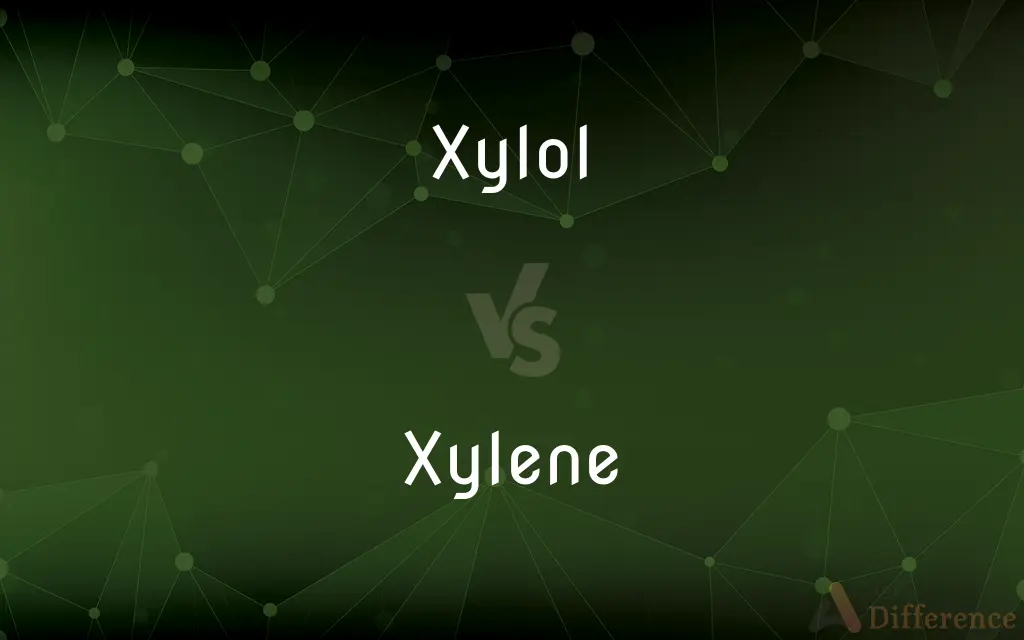Xylol vs. Xylene — What's the Difference?
By Fiza Rafique & Urooj Arif — Updated on April 30, 2024
Xylol and xylene refer to the same chemical compound, but "xylol" is an older term; xylene is commonly used in scientific contexts.

Difference Between Xylol and Xylene
Table of Contents
ADVERTISEMENT
Key Differences
Xylol, often considered an archaic term, is less frequently used in modern chemical literature and industry discussions. Xylene, on the other hand, is the more contemporary and universally recognized name, especially in academic and professional settings.
Xylol was historically used in various industries and contexts, implying its general use as a solvent. Whereas, xylene is specifically noted for its role in the production of polyethylene terephthalate (PET) and as a solvent in the printing, rubber, and leather industries.
In safety data sheets and chemical databases, the term "xylol" appears less frequently. On the other hand, xylene is consistently referenced, emphasizing its relevance and standardized usage across safety and regulatory documents.
Xylol might still be found in older literature or in certain colloquial uses, especially in various non-technical contexts. Xylene, conversely, is prevalent in scientific research, technical data sheets, and material safety documents, reflecting its current nomenclature in chemistry.
In educational materials, xylol is rarely mentioned; modern textbooks and resources predominantly use "xylene." This ensures consistency in teaching and aligns with international chemical naming conventions.
ADVERTISEMENT
Comparison Chart
Usage in Literature
Less common, archaic
Commonly used, modern
Industrial Application
General solvent use
Specific in PET production, solvents for printing and rubber industries
Safety and Regulation
Seldom mentioned
Regularly cited in safety documents
Current Nomenclature
Rare in current usage
Standard in chemical databases and literature
Educational Presence
Minimal in modern resources
Widely used in chemical education
Compare with Definitions
Xylol
A former name for xylene, used as a solvent.
Xylol was once commonly used in paints and varnishes.
Xylene
A mixture of three different isomers used industrially.
Xylene, as a mixture of isomers, offers versatility in industrial applications.
Xylol
An older term in organic chemistry referring to a specific isomer of xylene.
Xylol, specifically ortho-xylol, was studied for its properties in early chemical research.
Xylene
A clear, colorless liquid with a characteristic odor.
Xylene's odor is quite noticeable in laboratory settings.
Xylol
An aromatic hydrocarbon solvent.
Xylol's effectiveness in cleaning applications was well-regarded in the early 20th century.
Xylene
A hazardous material requiring careful handling.
Xylene must be handled with protective equipment due to its toxicity.
Xylol
A component in the manufacture of certain chemicals.
Xylol was essential in the production of certain synthetic resins.
Xylene
A solvent in the leather tanning process.
Xylene is used to improve dye penetration in leather processing.
Xylol
A solvent used in the printing industry.
Xylol helped in maintaining ink consistency during the printing process.
Xylene
A volatile organic compound used as a solvent in various industries.
Xylene is vital for thinning paints and varnishes.
Xylol
Variant of xylene.
Xylene
Xylene (from Greek ξύλον xylon, "wood"), xylol or dimethylbenzene is any one of three isomers of dimethylbenzene, or a combination thereof. With the formula (CH3)2C6H4, in each of the three compounds a benzene ring is substituted by two methyl groups.
Xylol
Xylene
Xylene
Any of three colorless flammable isomeric benzene derivatives, C8H10, obtained from wood and coal tar.
Xylol
Same as Xylene.
Xylene
A mixture of xylene isomers used as a solvent in making lacquers and rubber cement and as an aviation fuel.
Xylol
A colorless flammable volatile liquid hydrocarbon used as a solvent
Xylene
(chemistry) Any of a group of three isomeric aromatic hydrocarbons, found in coal and wood tar.
Xylene
Any of a group of three metameric hydrocarbons of the aromatic series, found in coal and wood tar, and so named because found in crude wood spirit. They are colorless, oily, inflammable liquids, C6H4.(CH3)2, being dimethyl benzenes, and are called respectively orthoxylene, metaxylene, and paraxylene. Called also xylol.
Xylene
A colorless flammable volatile liquid hydrocarbon used as a solvent
Common Curiosities
Is xylene the same as xylol?
Yes, xylene and xylol refer to the same chemical compound, though "xylene" is the more accepted term today.
Why is xylol less used today?
Xylol is considered outdated and has been largely replaced by the term xylene in modern chemical nomenclature.
What is xylol?
Xylol is an older term for xylene, which is used mainly as a solvent.
Can xylol still be found in any products?
While less common, xylol may still appear under this name in some older or less technical contexts.
Where is xylene used?
Xylene is used in industries like printing, rubber, leather, and in the production of PET.
Are there safety concerns associated with xylene?
Yes, xylene is toxic and requires careful handling and proper protective equipment.
How is xylene handled safely in industrial settings?
Xylene handling involves ventilation, personal protective equipment, and adherence to regulatory safety standards.
What are the physical properties of xylene?
Xylene is a clear, colorless liquid with a distinctive sweet smell.
What are the emergency procedures for xylene spills?
Emergency procedures include evacuating the area, using absorbent materials for spills, and ventilating the area.
Is xylene environmentally hazardous?
Xylene is considered a pollutant and can impact water sources and air quality.
How is xylene transported safely?
Xylene is transported in specially designed containers to prevent leaks and spills.
What industries primarily use xylene?
Xylene is prominently used in the paint, rubber, printing, and leather industries.
Can xylol and xylene be used interchangeably in chemical formulas?
Yes, since they are the same compound, xylol and xylene can technically be used interchangeably in formulas, although "xylene" is preferred for clarity and modern usage.
What are the common uses of xylene in everyday products?
Xylene is often found in thinners, inks, and adhesives.
How does xylene affect human health?
Inhalation or prolonged exposure to xylene can cause health issues like headaches, dizziness, and respiratory problems.
Share Your Discovery

Previous Comparison
Mountain vs. Butte
Next Comparison
Trainee vs. InternshipAuthor Spotlight
Written by
Fiza RafiqueFiza Rafique is a skilled content writer at AskDifference.com, where she meticulously refines and enhances written pieces. Drawing from her vast editorial expertise, Fiza ensures clarity, accuracy, and precision in every article. Passionate about language, she continually seeks to elevate the quality of content for readers worldwide.
Co-written by
Urooj ArifUrooj is a skilled content writer at Ask Difference, known for her exceptional ability to simplify complex topics into engaging and informative content. With a passion for research and a flair for clear, concise writing, she consistently delivers articles that resonate with our diverse audience.












































